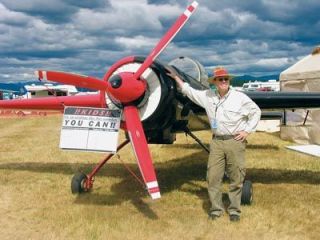ARLINGTON The most striking diversity of the 39th Annual Arlington Northwest Experimental Aircraft Association Fly-In, at the Arlington Airport July 11-15, was found in all the reasons that aviation enthusiasts are interested in the field of flight.
John Coffey, president of Seattle Chapter 67 of the EAAs International Aerobatic Club, emphasized the importance of education to younger prospective aviators.
I studied lots of math, Coffey said. The more you learn, the more fun it becomes. I spent lots of time reading and writing, not only so that I could learn, but also so I could explain what Id learned to others. I studied engineering so I could learn how to build things and, of course, I learned how to fly.
The aerobatics category focuses on correct execution of specific maneuvers as its pilots give each other grades on the mechanics of their flights, from the straightness of their lines to the roundness of their loops. The additional strain that their maneuvers place on their planes require that aerobatically certified aircraft and pilots alike must withstand greater G-forces.
Coffey was initially inspired to take this disciplined path by the sense of freedom he felt when he and his brother flew with their father as children.
He was a sailplane pilot, Coffey said. I remember being really excited when he made a high-bank turn and I looked off the end of the wing to see a cow below us, at about 2,000 feet. It was such a rush to see things from a different perspective like that.
While aerobatic pilots seek to hone their skills, the light sport category of aircraft is presented by many of its pilots as a more accessible alternative to both younger pilots, relatively new to the field of flying, and older pilots not ready to stop being aviators.
Many people think youve got to be an insider in this world to know how it works, said Mike Lynch, flight instructor for Out of the Blue Aviation in Arlington, which is now training potential pilots in the relatively new field of light sport aircraft aviation. Its actually not that different from riding a motorcycle or steering a boat across a lake, except that youve got another dimension to deal with. Piloting is all about managing risk safely. In that regard, its the same as driving a car.
Under the light sport category of certification, aspiring pilots are only required 20 hours of flight time before they can apply for their licenses, which is half the flight time required for a private pilots license.
That means theyre only paying half, maybe even a third, to obtain their pilots licenses, Lynch said. There are restrictions for air space and speed and they cant fly at night or with more than one passenger, but once we get them in the door, a lot of folks find it so enticing that they go on to learn more about flying and many even make it a career.
Out of the Blue has become the Pacific Northwest dealer for Light Sport Airplanes West, a distributor of eight different new light sport aircraft. Mike Fletcher, founder of Light Sport Airplanes West, credits light sport aviation with allowing him to return to flying.
If you fail a certification for medical reasons, youre pretty much through as a pilot for the rest of your life, Fletcher said. If you let it expire, though, you can still fly light sport planes with your drivers license. Being able to fly again is like rediscovering sex.
As light sport aircraft pilots hope to increase the pool of recreational aircraft pilots in the future, so do the members of the Replica Fighters Association aim to preserve their favorite pieces of the aviation fields past, by putting together planes that recreate the models of the previous eras, albeit with modern parts.
Steve Hoffman, an Arlington RFA on-site coordinator at the Fly-In, touted the scale replica aircraft as representing an important part of our history. Hoffman noted that an ever-increasing number of the original warbirds are either falling into terminal disrepair or being moved into museums, so the replica fighters that the RFA pilots maintain in operable order keep the history of these aircraft alive and flying.
According to Hoffman, the purpose of the RFA is to aid these replica fighter builders and pilots, not only by directing them toward affordable construction materials for their aircraft, but also by ensuring that the ready-to-assemble kits for each model are put together into safe and sturdy planes because we want these replicas to have a good reputation.
In contrast to the replica fighter pilots, who take pains to recreate the authentic appearances of antiquated aircraft, the ultra-light pilots see their aircraft as more of a means to an end.
Its as close as youll come to flying like a bird, said Rob Lyons of Adventure Aviation.
The ultra-light division of aircraft is made up of skeletal-looking recreational flying vehicles that the Federal Aviation Administrations regulations state can weigh no more than 250 pounds, can travel no faster than 65 miles per hour at full speed and can carry only single pilots, with no passengers, except for the two-seater models that are used to train new ultra-light pilots.
Lyons uses two-seater ultra-light pilot-training aircraft to give first-time flyers a taste of what the ultra-light experience can be like. Lyons explained that ultra-light flying offers spectacular views, from perspectives that most people will never see.
Arlington Fly-In packs in planes, people
ARLINGTON The most striking diversity of the 39th Annual Arlington Northwest Experimental Aircraft Association Fly-In, at the Arlington Airport July 11-15, was found in all the reasons that aviation enthusiasts are interested in the field of flight.



